History of European Sculpture
This is a brief guide to the significant points in the
development of European sculpture up to the 20th.C.
If any of the sections inspire you to look deeper, then go to your
library or bookshop - there are many good specialist books on
everything pointed at here.
|
If you're fond of looking things up on the web, then beware...
I would guess that 20% of pictures found on Pinterest are credited to the wrong artist.
These mistakes can happen on any website where Googlers can "post" images... eg.Facebook is also full of tosh.
|
Prehistoric sculpture
"Prehistoric art" is the art created by pre-literate
cultures continuing until that culture develops writing,
and starts recording historical events. At this point
"ancient" art begins. The dates for these terms
varies greatly between different parts of the world.
The earliest piece of figurative sculpture is the
Venus of Hohle Fels which was found in Germany,
carved out of mammoth ivory 35,000 years ago.
The Venus of Dolni Vestonice, found in Czechoslovakia
is the oldest ceramic piece, made of clay and fired at a
low temperature 29,000 years ago.
The most famous Ice Age piece is the Willendorf Venus,
found in Austria, made of limestone, 25,000 years ago.
|
|
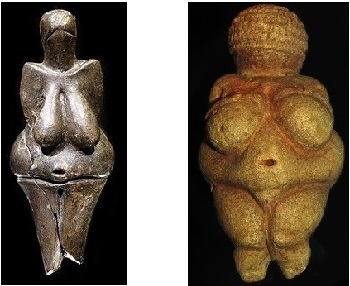
|
Mesopotamia
The art of Mesopotamia reaches from the early hunter-gatherer
societies of the 10th millenium BC to the Bronze age cultures
of the Sumerian, Babylonian and Assyrian empires.
Widely considered to be the cradle of civilization, Mesopotamia
brought significant cultural developments. Their art rivalled
that of ancient Egypt as the most sophisticated in Eurasia
from the 4th millenium BC.
Favourite subjects include deities, alone or with worshippers,
animals in various types of scenes: repeated in rows, alone,
or fighting each other or humans.
There are a number of figures of large-eyed priests and
worshippers, mostly in alabaster and up to a foot high.
Animals are often shown as representing gods.
|
|
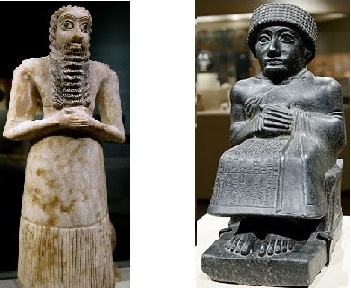
|
Egypt
Ancient Egyptian sculpture was produced in the Nile Valley
from 3,000 BC to 100 AD. Most of the surviving art comes
from tombs and temples, hence the emphasis on
life after death. Symbolism is all-pervasive, and conventions
were strictly followed as to how each God could be represented,
eg. Anubis was always shown with a jackal's head, while
Sobek had a crocodile head. Because of these conventions
the appearance of statues changed very little over the
3,000 years.
Figures are carved in totally rigid, frontal poses with legs
parted as if walking. Cats were also popular subjects, posed
as if they were stuffed. Interesting, but hardly "art".
But, their friezes were innovative - sunken reliefs which cast
dramatic shadows in bright sunlight.
Cutting was done done with copper and bronze tools, and sand
was used as an abrasive. They had plenty of that.
|
|

|
Greek sculpture
Geometric period 900-700 BC.
The earliest Greek sculpture was mostly in wood, none of
which has survived. Later they used terracotta and ivory,
and bronzes were cast using the lost wax method introduced
from Syria. Typical of this era is the Karditsa Warrior.
The Archaic period 660-580 BC.
The Greeks began to carve in stone, inspired by the
sculpture of Mesopotamia and Egypt. Poses were based on
the Egyptian frontal poses, but these figures were carved
with the creepy "archaic smile", to give them a human
look. Most carvings were of the Kouros (nude male)
and the Kore (clothed female), both of which had very
generalised features - no attempt at realism yet.
The Kouros were always depictions of young men, even when
placed on the graves of elderly citizens. Female nudity
was still taboo, but they developed important new techniques
to represent drapery.
|
|

|
The Classical period 480-323 BC.
This period saw a revolution in sculpture, associated
with the introduction of democracy. There was a dramtic
increase in the technical skill of sculptors in depicting
realistic human forms. Poses became more naturalistic.
This was the start of individual sculptors being credited
for their work: Phidias oversaw the building of the
Parthenon. Praxiteles created the Aphodite of Knidos, the
first greek sculpture of a nude female. This statue ended
the taboo and started the genre of the female nude.
Polykleitos developed a set of idealised proportions
for the human form, he started the "8-heads" rule that is
still taught today.
|
|

|
Hellenistic period 323-31 BC.
This period runs from the death of Alexander the Great to
the death Cleopatra. Hellenistic sculptors put naturalism
above classical idealism. Sculptors no longer felt obliged
to depict people as ideals of beauty or physical perfection.
Statues were made in more expressive and animated poses,
showing more emotion, and were designed to be viewed from
all angles. The female nude is now a popular theme, often
depicting Aphrodite/Venus being suprised getting out of a
bath - there are so many variations on this theme that they
are given their own sub-genre "Venus Pudica".
The main theme though is still the male nude - Gods and Heroes
shown with perfect athletic bodies.
The demand for statues in Hellenistic cities turned sculpture
into an industry, with consequent standardisation and some
lowering of quality. Most original Greek sculpture that has
survived is from this period - nearly all the Classical period
sculptures we know are actually Roman copies.
This period also saw the first written works of art history.
|
|

|
Roman sculpture
The Roman Empire lasted until the 1400's but most of the
important Roman sculpture was produced in the period
100 BC to 200 AD.
Appreciation of Roman sculpture is complicated by its
relationship to Greek sculpture. Many original Greek
statues were lost, melted down or otherwise destroyed
and are only known to us through later Roman copies.
The Romans loved Greek sculpture and even set up a school
in Rome to teach romans how to copy greek statues. They
didn't add many ideas of their own but produced copies
of the Greek originals that were often technically better.
They preferred to carve historical works as friezes rather
than compete with the free-standing sculpture of the Greeks.
Portraiture is a dominant genre of Roman sculpture, and
their innovation was to carve "warts and all", in contrast
to the Greeks who "idealised" all their figures.
|
|
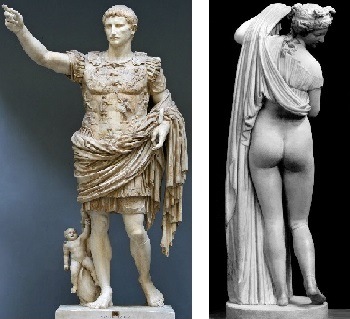
|
Byzantine Art - When Sculpture nearly died
Byzantine art refers to the art of the Eastern Roman Empire.
The Byzantine Empire emerged from Rome's decline and lasted
until the Fall of Constantinople in 1453.
Byzantine art abandonded classical ideas of representing
reality in favour of an abstracted, symbolic approach. Their
subject matter was mostly Christian, especially the
"Madonna and child", and these "Icons" had more to do with
worship than art for art's sake.
Sculpture fared particularly badly, and nothing of artistic
significance was made in over 1,000 years. Their limit was
small scale ivory carvings of religious figurines.
Losses of Classic art
To make matters worse, two periods of Iconoclasm (religious
zeal) in 787 and 814 AD saw the widespread destruction of
much Classical art. Then, the infamous Sack of Constantinople
in 1204 saw the Crusaders loot and vandalise the capital city
and many Greek and Roman art works were stolen or destroyed.
Bronze sculptures were melted down for their scrap metal value.
These were truly the "Dark Ages".
|
|

|
The Renaissance - Sculpture is reborn
The Renaissance was a cultural re-awakening starting in Italy
in 1400 AD. Scholars became interested in the classical culture
of ancient Greece and Rome, and studied texts on philosophy,
poetry, science and the arts.
The 1st awakening for sculpture actually started in the 13th.C
when Pisa sculptor Nicola Pisano started to be influenced by
Roman sarcophagi, then his son Giovanni Pisano continued
his work. However, the Renaissance proper was kick-started in
1401 by a competition to sculpt a set of bronze doors for
Florence cathedral. This brought sculptors Brunelleschi,
Ghiberti and Donatello to fame. Donatello had been Ghiberti's
assistant but soon became THE man of the early Renaissance.
Sculpture had returned to the Hellenistic style of very life-like
portrayals of nude mythological heroes in dramatic poses.
The later Renaissance had many skilled sculptors such as Bardinelli, Cellini,
and Giambologna, but they were overshadowed by Michelangelo, who was considered one of
the greatest artists of all time, and had an unparalleled
influence on the development of western art. His "David" is one
the most famous and admired sculptures ever, despite the
incongruous size of David's right hand in relation to the
family jewels. "Hung like a Gorilla" is the phrase that comes to mind.
|
|

|
After The Renaissance
Mannerist sculptors reacted to the idealised naturalism of
the High Renaissance by developing an elegancant and arty
style where their figures had strangely elongated limbs, and
very small heads.
After that the Baroque sculptors emphasised dynamic
movement and energy, their figures often "spiralled round
an empty central vortex and reached out to the surronding
space", all very theatrical. Bernini was an a master at
carving marble, and his dramatic large-scale sculptures
earned him comparisons with Michelangelo.
The Baroque style fell out of favour with the arrival of the
Neoclassical movement in the 18th C. This is considered
one of the great ages of public sculpture. They returned to
the purity of Hellenistic sculpture.
The leading sculptor of
the age was Canova who had been trained as a sculptor
by his stonemason grandfather since he was 5 years old - he
was carving marble by ten. He studied at the Venice art
academy then went to Rome to sketch Michelangelo. The
"pointing machine" was invented by a frenchman but Canova
perfected it, and set up a workshop where he had assistants
to do the initial marble copies leaving him to do the finishing
stages. So, he was quite prolific...
|
|
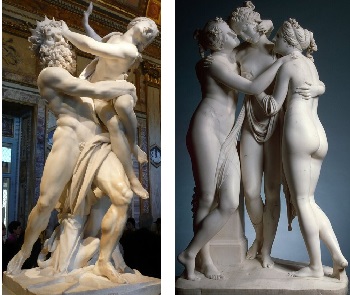
|
Modern Classicism
By the 19th C. the main centre for sculpture had shifted from
Italy to northern Europe, especially Paris. Sculptors became
less interested in the absolute realism of Michelangelo and
Canova, and mostly abandoned Greek mythology as subject
matter in favour of ordinary people in fleeting poses.
The master of this era was Auguste Rodin, now considered
the father of modern sculpture. He felt "love at first sight"
with sculpture at 17, and trained at the Petit Ecole in Paris.
But, he failed the entrance exam for the Ecole Des Beaux Arts 3 times.
17 years later he travelled to Rome to study Michelangelo. After
that he sculpted "The age of bronze" which was so life-like he
was accused of body casting. He had an influencial friend who
cleared his name, and this led to a change in fortune. Many of
his pieces were scorned and the press didnt like him, but he
eventually became rich and respected among his artist peers.
Like Canova he set up a workshop to employ assistants to
make multiple copies of each piece. Unlike Canova, Rodin himself only worked in
clay, all the marble was carved by assistants.
He had a 15 year affair with one of his pupils, Camille Claudel. She became his
model and assistant and had a profound influence on his work in
what was called "The Camille Period". NOW she is recognised as
the greatest female sculptor of her time, but then, after their affair
finished she was considered "mad" for accusing the famous Rodin
of taking credit for her ideas. Her brother had her committed and he repeatedly
refused the doctors' advice to let her out. She died in hospital,
a victim of male dominated times.
Another important sculptor to pass through Rodin's "factory" was
Maillol. His own works were more emotionally restrained,
and concentrated on pure form. As such his work became a big
influence on modern sculptors such as Brancusi, Arp and Moore.
|
|
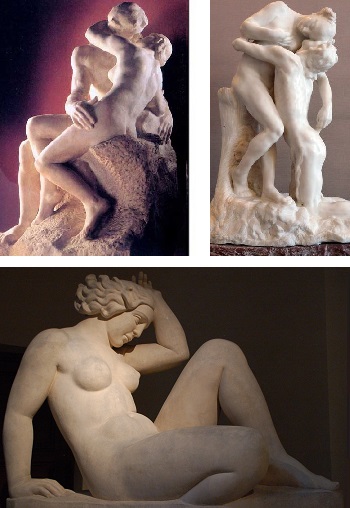
|
More Sculptors....
To keep it brief the above timeline only mentions certain key sculptors,but there are many more well worth a look at.
Here is a selection from my collection of the famous and not-so-famous.
|
Alexandre Schoenewerk
- Young Tarantine
|
|

|
Auguste Ottin
- The Nymph Galatea in the arms of the shepherd
|
|

|
Piero de Verona
- Tomba Burrano, Cimitero di Staglieno
|
|

|
Auguste Clesinger
- Woman bitten by a snake
|
|

|
HW Bissen
- The wrathful Achillies
|
|

|
James Pradier
- Satyr and Bacchante
|
|
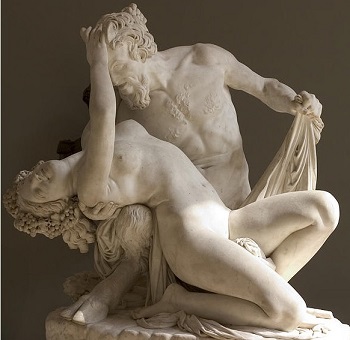
|
Frederic Leighton
- The Sluggard
Laurent-Honore Marqueste
- Perseus Slaying Medusa
|
|

|
Christope-Gabriel Allegrain
- Bathing Venus
Bertram Mackennal
- Diana wounded
|
|
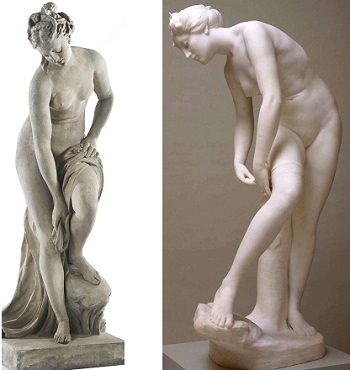
|
Victor Rousseau
- The Secret
|
|
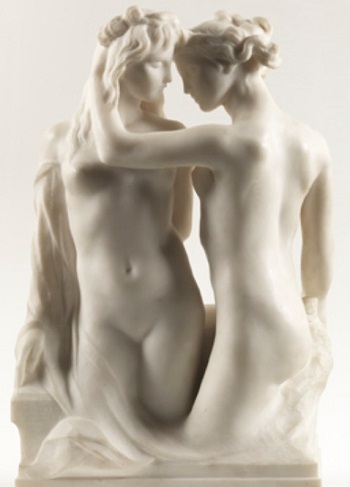
|
Nicola Pisano
- Pisa Pulpit
Donatello
- David
|
|
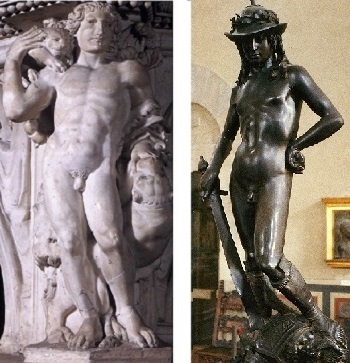
|
Benvenuto Cellini
- Perseus
Baccio Bandinelli
- Hercules and Cacus
|
|
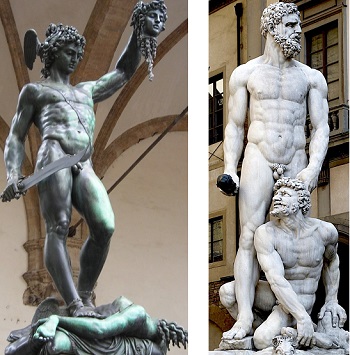
|
Vincenzo de Rossi
- Hercules and Diomedes
There's a few reproductions of this, often showing a quite playful hold on Herc's todger. The original however has a real nutcracker grip. This, far from being homoerotic is an eye watering message about Mutually Assured Destruction...
|
|
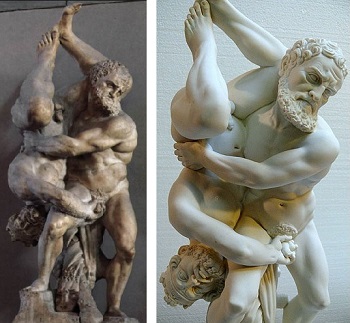
|







